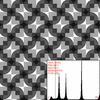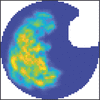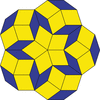issue contents
May 2022 issue

Cover illustration: Structure determination for polymeric or fibrillar assemblies (e.g. helical viruses, microtubules, nucleic acids etc.) is difficult since they usually pack spontaneously into bundles and the resulting diffraction is cylindrically averaged. The cylindrical averaging can be circumvented, however, by using new high-intensity sources such as X-ray free-electron lasers to measure diffraction from single such assemblies. Arnal & Millane [Acta Cryst. (2022). A78, 249–261] describe a method for ab initio phasing of the information-rich diffraction data from 1D crystals that are Bragg sampled only along the fibril axis direction. The cover image shows simulated diffraction from a single B-DNA molecule (left) and an ab initio reconstruction of the electron density (right) using iterative projection and shrink-wrap algorithms.
advances
research papers
 access
access access
accessfoundations
research papers
 access
access access
access access
access access
accessbook reviews



 journal menu
journal menu





























